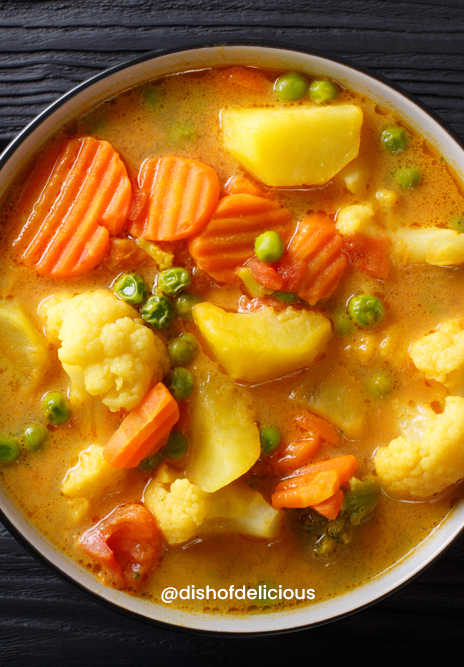Indian cuisine is renowned for its rich flavors and aromatic spices, and one dish that perfectly embodies these qualities is the classic Indian Veg Curry. This wholesome and flavorful dish is a medley of colorful vegetables cooked in a luscious blend of spices, creating a delightful symphony of tastes. In this food blog, we’ll take you through an easy step-by-step guide on how to prepare this delectable veg curry in the comfort of your own kitchen. So let’s dive in and explore the magic of Indian flavors!
What is Curry?
Curry is a popular and versatile dish that originated in the Indian subcontinent. It refers to a combination of spices, vegetables, meat, or legumes, cooked together to create a rich, flavorful, and aromatic dish. Curries are an integral part of Indian cuisine, known for their diverse tastes and regional variations.
All About Indian Veg Curry:
Indian Veg Curry, also known as “sabzi” in Hindi, is a vegetarian version of the traditional curry. This delightful dish is a medley of assorted vegetables cooked in a harmonious blend of aromatic spices. Indian Veg Curry is celebrated for its vibrant colors, tantalizing aroma, and an explosion of flavors on the palate.
Ingredients You’ll Need:
To prepare this scrumptious Indian Veg Curry, gather the following ingredients:
- Assorted Vegetables (carrots, potatoes, cauliflower, bell peppers, peas, etc.)
- 2 large onions, finely chopped
- 3 ripe tomatoes, pureed
- 2-3 green chilies, finely chopped
- 4-5 garlic cloves, minced
- 1-inch piece of ginger, grated
- 1/4 cup cooking oil or ghee
- 1 teaspoon cumin seeds
- 1/2 teaspoon turmeric powder
- 1 tablespoon coriander powder
- 1/2 teaspoon red chili powder (adjust to your spice preference)
- 1 teaspoon garam masala
- Salt to taste
- Fresh cilantro leaves for garnish
- Water
Introduction: Step-by-Step Guide to Making Indian Veg Curry–
- Step 1: Wash and chop the assorted vegetables into bite-sized pieces.
- Step 2: In a large pot or pan, heat the cooking oil or ghee over medium heat. Add cumin seeds and let them sizzle.
- Step 3: Add chopped onions and sauté until golden brown.
- Step 4: Stir in minced garlic, grated ginger, and chopped green chilies. Sauté for a minute.
- Step 5: Add pureed tomatoes and cook until the oil separates.
- Step 6: Lower the heat and add turmeric powder, coriander powder, red chili powder, and salt. Mix well and cook for a couple of minutes.
- Step 7: Add chopped vegetables and coat them evenly with the spices.
- Step 8: Pour enough water to cover the vegetables and bring the curry to a gentle simmer. Cover and cook until vegetables are tender.
- Step 9: Sprinkle garam masala over the curry and garnish with cilantro leaves. Your Indian Veg Curry is now ready to be served!
Tips for a Perfect Veg Curry:
- Experiment with different vegetable combinations for variety.
- To achieve a creamier texture, add cashew paste or coconut milk.
- Adjust the spice level to your preference by modifying the chili content.
- Roast and grind whole spices for an enhanced flavor.
Variations to Spice Up Your Veg Curry:
- Paneer Veg Curry: Add Softness to the Spices-
- Upgrade your veg curry by incorporating chunks of soft paneer (Indian cottage cheese). Paneer beautifully absorbs the rich flavors of the curry, creating a velvety and satisfying texture. To make Paneer Veg Curry, simply substitute some of the vegetables with paneer cubes during the cooking process. This variation is a hit among vegetarians and adds a touch of indulgence to your meal.
- Coconut Veg Curry: Creaminess with a Tropical Twist–
- If you’re in the mood for a creamy and tropical delight, Coconut Veg Curry is the perfect variation for you. To achieve this delectable twist, substitute water with coconut milk during the cooking process. The coconut milk adds a mild sweetness and smoothness to the curry, perfectly balancing the array of spices and vegetables. This variation is a great way to infuse your curry with exotic flavors and take your taste buds on a blissful journey.
- Chickpea Veg Curry: A Hearty Protein Boost-
- For those seeking a protein-rich option, Chickpea Veg Curry is a delicious and wholesome choice. Adding boiled chickpeas to the curry not only enhances its nutritional value but also adds a unique nutty flavor and hearty texture. Chickpeas are known for their versatility and make the curry more filling, making it a satisfying and balanced meal on its own.
- Spinach and Potato Veg Curry: A Nutritious Green Delight-
- Incorporate the goodness of spinach and the comfort of potatoes into your veg curry. Spinach adds a vibrant green color and a wealth of nutrients to the dish, while potatoes bring a mild earthiness and a hearty feel. The combination of spinach and potatoes in the curry provides a delightful contrast in flavors and textures, making it a wholesome and nutritious choice.
- Mushroom and Peas Veg Curry: An Earthy Combination-
- If you’re a fan of earthy flavors, this variation is sure to please your taste buds. The combination of tender mushrooms and sweet green peas creates a harmonious blend of flavors in the curry. Mushrooms add an umami richness, while peas bring a touch of sweetness. This delightful variation is a delightful way to enjoy the natural flavors of the vegetables in your curry.
- Mixed Lentil Veg Curry: A Hearty and Filling Delight-
- To take your veg curry to the next level of heartiness, consider adding a mix of lentils. Combining various lentils like red lentils, green lentils, and black lentils creates a protein-packed and satisfying dish. Lentils not only provide a hearty texture but also absorb the flavors of the spices beautifully, resulting in a curry that’s rich, nutritious, and utterly delicious.
Conclusion: Embrace the Magic of Indian Flavors–
Indian Veg Curry is a celebration of the rich and diverse flavors found in Indian cuisine. By following this simple recipe, you can create a mouthwatering and wholesome dish that will leave everyone craving for more. So, roll up your sleeves and dive into the world of Indian spices to relish the magic of this classic veg curry. Enjoy the goodness of homemade Indian food with every spoonful! Bon appétit!
Frequency Asked Questions (FAQ):
Q1: What is Indian Veg Curry?
A1: Indian Veg Curry, also known as “sabzi” in Hindi, is a popular vegetarian dish from the Indian subcontinent. It comprises a delightful medley of assorted vegetables cooked with a harmonious blend of aromatic spices, creating a rich, flavorful, and aromatic curry.
Q2:Can I make Indian Veg Curry in advance?
A2: Yes, you can prepare Indian Veg Curry in advance. It stores well in the refrigerator for up to 3-4 days in an airtight container. You can reheat it on the stove or in the microwave before serving. Just make sure to cool it down to room temperature before storing it.
Q3: Can I freeze Indian Veg Curry?
A3: Yes, you can freeze Indian Veg Curry for later consumption. Allow the curry to cool completely, transfer it to a freezer-safe container, and store it in the freezer for up to 2-3 months. Thaw it overnight in the refrigerator before reheating.
Q4: Can I add protein to the Indian Veg Curry?
A4: Absolutely! While Indian Veg Curry is traditionally a vegetarian dish, you can add protein to it. Options include adding soft paneer cubes, boiled chickpeas, or even tofu for a vegan version. These additions enhance the nutritional value and taste of the curry.
Q5: What is the best way to serve Indian Veg Curry?
A5: Indian Veg Curry pairs wonderfully with steamed rice, naan, roti, or any Indian bread of your choice. You can also serve it with quinoa or couscous for a modern twist. Garnish with fresh cilantro leaves and a dollop of yogurt for added flavor.
Q6: Are there any health benefits to eating Indian Veg Curry?
A6: Yes, Indian Veg Curry is packed with the goodness of assorted vegetables and aromatic spices, making it a nutritious meal. It provides a wide range of vitamins, minerals, antioxidants, and fiber from vegetables, promoting overall health and well-being. Additionally, the spices used in the curry have various health benefits, such as boosting metabolism and aiding digestion.



